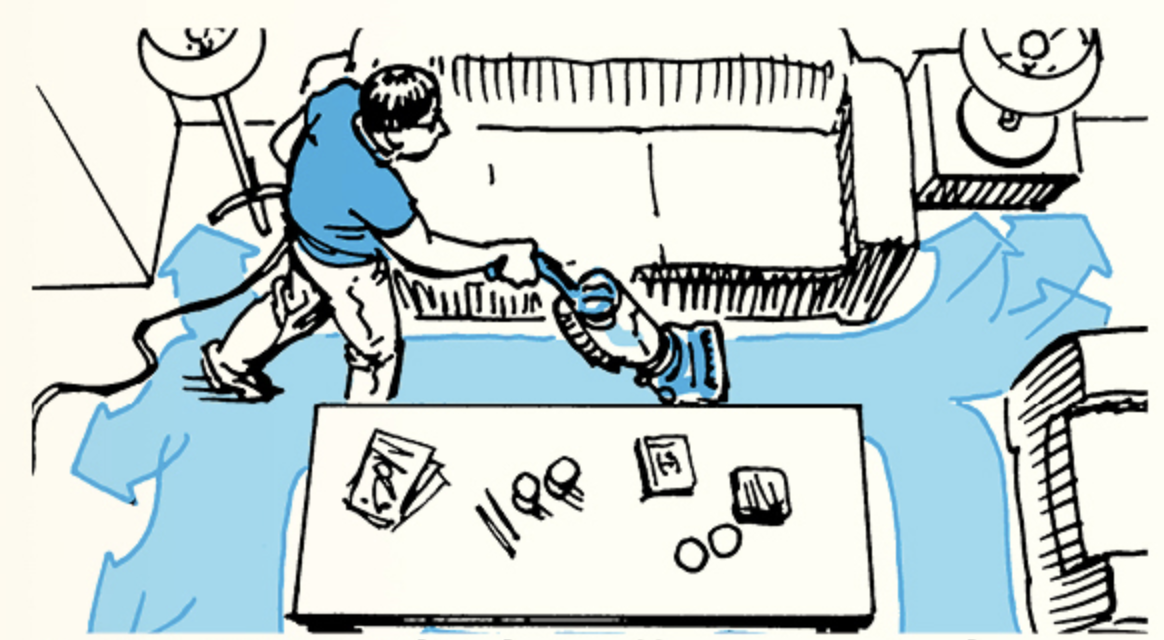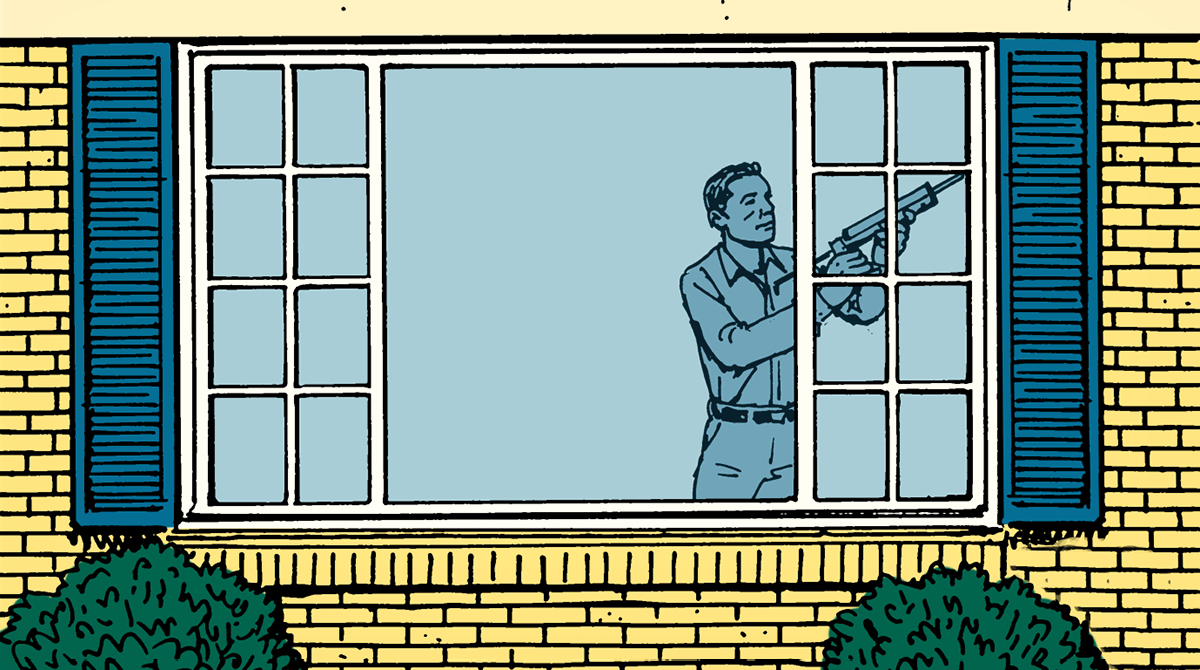
When Kate and I were shopping for a home more than a decade back, I remember feeling clueless about what I should be looking for during an open house.
Sure, I could assess if the kitchen layout was attractive and whether or not the office seemed cool, but I didn’t know what other kinds of things — like structural and maintenance issues — I should keep an eye out for to avoid getting my heart set on a lemon of a house.
Basically, I wanted to know how to do my own pre-inspection of a house before I made an offer and went through the professional inspection that follows.
Over the years, I’ve had some AoM readers ask a similar question, so I reached out to Nick Thruston, a home inspector and owner of Glen Allen Inspections in Richmond, VA for some advice. Before Nick was a home inspector, he sold homes, so he has some good insights for potential home buyers.
Nick says there are certain things to be on the lookout for when you’re doing a walkthrough inspection that go beyond your overall impression of the home.
Assessing Deferred Maintenance Issues
During your walkthrough inspection, it’s crucial to pay attention to deferred maintenance issues. These are things that the current homeowner should have kept up with, but didn’t. They may not be immediately obvious but can have long-term implications if left unaddressed.
If you’re hoping to avoid spending a lot of time and money on home repairs after you buy a house, then you may want to pass on one that has a lot of these deferred maintenance issues.
Or, if you still want the house, you might be able to bring up these deferred maintenance items when you’re negotiating the price of the home to try to knock it down a bit.
Even if you’re not successful in using that tactic in today’s tight housing market, it’s still good to be aware of deferred maintenance issues, as this will help you have a ballpark estimate of the house’s true cost. Let’s say the home you’re considering buying is $450,000, but it has about $20,000 of deferred maintenance costs you’ll likely have to pony up for over the next ten years. Now you can think of the house as really costing $470k rather than $450k. It’s a way to help you budget, basically.
While every home is unique, Nick said there are some common deferred maintenance items to watch out for:
Exterior: For brick homes, inspect the mortar for flaking or missing sections. These can indicate potential water intrusion problems. Also check out the driveway and sidewalk; do they need repaving?
Interior: Take a peek under sinks to check for leaks. Look at the ceiling for any stains that may suggest water damage. Operate doors to ensure they open and close properly, as misaligned doors could be a sign of foundation settlement.
Water Sources: Pay attention to areas around water sources like toilets and shower enclosures, looking for any soft flooring, which could indicate water damage or poor maintenance.
By taking the time to observe these deferred maintenance items, you can create a list of potential concerns or future expenses that may impact your budget. Keep in mind that while some issues may be minor, others could require significant repairs, so it’s essential to factor them into your decision-making process.
Evaluating Big-Ticket Items
Apart from deferred maintenance, it’s crucial to assess the condition of what Nick calls “big-ticket items” in the house. These items can significantly impact your budget and the home’s overall functionality. Here’s what you should look for:
Roofing: Be sure to take a good look at the roof. Know its age. Assess its condition. Look for patchy shingles, plant/moss growth, and debris on the roof. Also check for clogged gutters, missing downspouts, and any signs of water damage.
While minor patchiness or moss growth may not be deal-breakers, consider budgeting for a new roof if the current roof is old and shows significant signs of wear and tear.
Windows. How old are the windows? Windows last an average of 15-30 years, so if they’re on the older side, they may need replacing sooner rather than later.
HVAC Systems: Check the functionality of the heating, ventilation, and air conditioning (HVAC) systems. Nick recommends that people take note of the ambient temperature of the house while they’re walking through it:
I can go into a house and an HVAC system might not be working all that well, or maybe it’s broken, and I’ll ask the buyers, ‘Hey, when you were here for your showing, how was the temperature?’
And a lot of times, they’re just kind of clueless. They don’t remember. And I get it; they’ve been going around, looking at lots of homes, losing out on contracts. But just paying attention to whether the A/C works in a home when you’re doing a walkthrough can save you a lot of hassle during the offer process.
Check how the temperature in the house feels against what the thermostat is set to; if the house feels colder/hotter than it should given the temp it’s supposed to be at, that might mean there’s something wrong with the HVAC system, the insulation, the quality of the windows, and/or the seal of exterior doors.
Beyond that, inspect the data plates on the exterior and interior HVAC units to determine their age. HVAC units last an average of 15-20 years, so if they’re coming up against that expiration date, you’ll want to factor the replacement cost into your budget.
Foundation and Structural Integrity: While it’s best to leave a thorough evaluation to professionals, you can still look for potential signs of foundation issues during your walkthrough. Pay attention to any cracks on the exterior walls and observe if they transfer through the block into the foundation wall and down to the crawlspace or basement area.
Crawlspace: If the home has a crawlspace, take a quick peek in it. Does it have a vapor barrier (the thin plastic sheet that covers the ground)? What condition is the vapor barrier in? How’s the insulation look?
“If the crawlspace is in bad shape, it’s possible that you’ll need to spend up to $4,000 to get it in tip-top shape,” Nick told me.
Hot Buttons and Red Flags
In addition to deferred maintenance and big-ticket items, Nick says there are a few hot buttons and red flags to be aware of during your home inspection. These issues may require further investigation:
Polybutylene Piping: Polybutylene piping, commonly referred to as QEST piping, has a higher statistical rate of failure. While it’s not inherently defective, it may lead to water leakage issues. Check for gray-colored piping during your inspection, especially in homes built in the 1980s and 1990s.
PEX Piping: PEX piping has similar issues to polybutylene piping. Look for blue, red, or white flexible piping and check for any signs of white accumulation or leaks around the fittings.
Lead Paint. If the house was built before 1978, there’s a chance it contains lead paint. You can’t tell for sure if paint contains lead just by looking at it; it has to be tested. But if you’re checking out an older house, take note if there are places where the paint is chipping/peeling/cracking; lead paint becomes a health concern once it starts deteriorating.
If you suspect the presence of these kinds of pipings or lead paint, consult a professional for accurate identification and resolution.
Ask Around
An additional tip from a friend who’s recently been through a protracted homebuying process:
I’ve gleaned a lot of useful information from neighbors. If you can catch a neighbor, they’ll tell you the truth about a home, like if there have been drains that back up, water that pools in the backyard, etc. They can just give you an honest history. They are also valuable insights into the vibe of the neighborhood.
The Importance of a Full Evaluation
While your own walkthrough inspection of a home can provide valuable insights, it’s important to remember that it’s not a substitute for a comprehensive evaluation conducted by a professional home inspector. A professional inspection goes beyond what can be observed with an amateur’s eye and provides a more detailed assessment of the home’s overall condition. Use your pre-inspection to come up with a list of things that, should you decide to make an offer, you want to follow up with the official inspector about.
The process of buying a home can be both exciting and overwhelming. By focusing on key factors during your walkthrough inspection, such as deferred maintenance issues, big-ticket items, and potential red flags, you can make a more informed decision about whether a particular house is the right fit for you. Remember to consult professionals for a full assessment and budget for any necessary repairs or remediation. With careful consideration, you’ll be well on your way to finding your dream home.
Happy house hunting!







